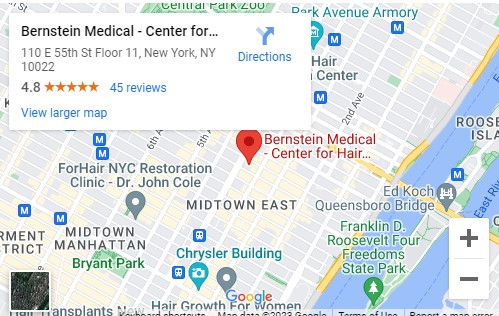Q: I was wondering if it was possible to use Follicular Unit Extraction (FUE) on the old plugs instead of graft excision. — N.B. ~ Westport, C.T.
A: Graft excision generally works better than FUE in removing old plugs and mini-grafts. The reason is that, in these grafts, the hair is not aligned due to the scar tissue that tugs on, and bends the hair. Because the hair direction is altered from the scar tissue, there is much more damage when the grafts are removed with the tiny FUE punches. In addition, FUE only removes a very small part of the plug. If the hair in the plug is pointing in the wrong direction or the plug is in the wrong location, the entire graft needs to be removed.
Another benefit of graft excision is that we can remove the underlying scar tissue and improve the appearance of the underlying skin. In FUE, only a tiny bit of the scar tissue is removed and, since FUE holes are left open, FUE actually causes its own scarring. With graft excision, the sites are sutured closed so some scar tissue is removed and the quality of the underlying skin looks more natural.
Read about Hair Plug Removal
Before/After Photos of a Plug Repair Patient


 Onalytica, a company that provides Influencer Relationship Management software and services, has named Dr. Bernstein one of the top influencers (#39 out of 100) on the topic of robotics due to his pioneering work in robotic hair transplant surgery with the ARTAS Robotic System.
Onalytica, a company that provides Influencer Relationship Management software and services, has named Dr. Bernstein one of the top influencers (#39 out of 100) on the topic of robotics due to his pioneering work in robotic hair transplant surgery with the ARTAS Robotic System. Dr. Bernstein presented results of his study, “Robotic Follicular Unit Graft Selection,” at the 2016 ISHRS World Congress held in Las Vegas, Nevada. Graft selection is a key advance in the ARTAS Robotic Hair Transplant System, a hardware and software suite that automates aspects of the Follicular Unit Extraction (FUE) hair transplant procedure. The enhancement makes Robotic FUE more efficient and improves patient outcomes.
Dr. Bernstein presented results of his study, “Robotic Follicular Unit Graft Selection,” at the 2016 ISHRS World Congress held in Las Vegas, Nevada. Graft selection is a key advance in the ARTAS Robotic Hair Transplant System, a hardware and software suite that automates aspects of the Follicular Unit Extraction (FUE) hair transplant procedure. The enhancement makes Robotic FUE more efficient and improves patient outcomes. Dr. Bernstein was featured in a wide-ranging interview published in the New York City-based, Japanese language magazine NY Japion. Among the topics discussed were the differences between FUT and FUE hair transplants, updates on robotic hair transplant technology, the type of procedure most beneficial for Asian patients, criteria that determine candidacy for a hair transplant, and more.
Dr. Bernstein was featured in a wide-ranging interview published in the New York City-based, Japanese language magazine NY Japion. Among the topics discussed were the differences between FUT and FUE hair transplants, updates on robotic hair transplant technology, the type of procedure most beneficial for Asian patients, criteria that determine candidacy for a hair transplant, and more.


